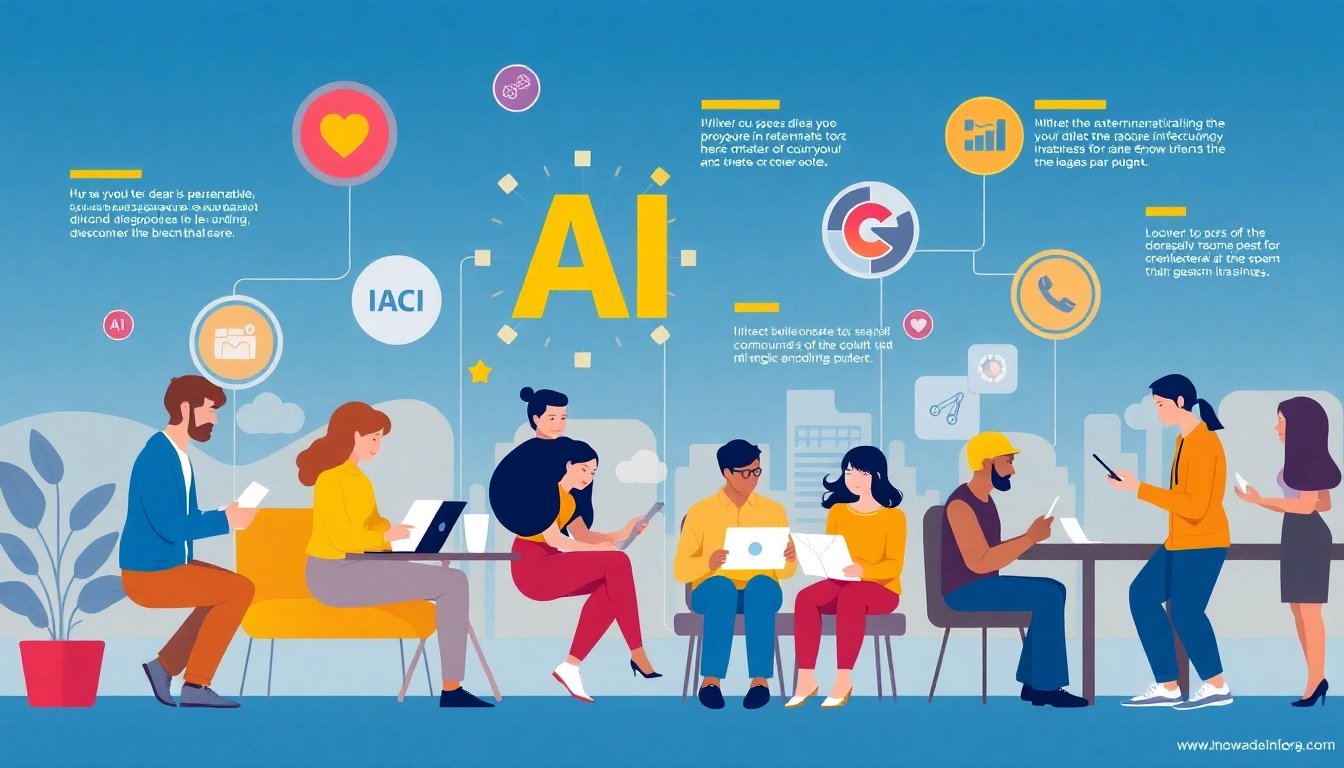Introduction to AI Opinion Polls
The rise of artificial intelligence (AI) has prompted a multitude of opinions and sentiments among the general public and domain experts alike. As this technology increasingly permeates various facets of life—from work environments to personal devices—understanding the public’s perspective becomes crucial. An AI Opinion poll serves as a valuable tool for gauging sentiments about AI technologies, revealing insights that can be critical for developers, policymakers, and marketers seeking to navigate this complex landscape. This article delves into the dynamics of AI opinion polling, exploring its significance, current trends in perception, and guiding principles for developing effective polls.
What Are AI Opinion Polls?
AI opinion polls are surveys or studies designed to measure the attitudes, beliefs, and sentiments of individuals regarding various aspects of artificial intelligence. They can encompass a wide range of themes, from general feelings towards AI’s presence in everyday life to opinions on specific applications, such as autonomous vehicles or AI in the workplace. The insights garnered from these polls help shape the narrative around AI—enabling stakeholders to understand concerns, excitement, and the overall societal impact of AI technologies.
Importance of Understanding Public Sentiment on AI
Grasping the public sentiment towards AI is crucial for several reasons. First, it allows developers and companies to tailor their products to meet the expectations and alleviate the concerns of potential users. As seen in recent surveys by organizations like Pew Research, public opinion can significantly influence the trajectory of AI development—highlighting the necessity for innovations that address societal fears, such as job displacement and ethical use. Furthermore, public sentiment can affect regulatory decisions; policies surrounding AI may change based on how the populace perceives its influence on various sectors.
How Polling Data Influences AI Development
Polling data can guide AI development in numerous ways. For example, if a significant portion of the public expresses concern about AI’s reliability or security, AI companies may prioritize enhancing these aspects in their offerings. Moreover, understanding which capabilities excite users can drive research and investment in those areas. Polling results are not just a reflection of public opinion; they provide concrete data that can encourage shifts in business strategies and technological innovations in response to consumer demands.
Current Trends in AI Perception
As of late 2023, various surveys have illuminated shifting perceptions of AI within American society. Studies reveal a complex web of concerns, hopes, and overall skepticism, which are critical for stakeholders involved in AI technology.
Recent Survey Results and Their Implications
Recent surveys report that a substantial majority of Americans show ambivalence toward AI—with many feeling more concerned than excited. For instance, a Pew Research study highlights that 52% of Americans expressed more concern than excitement about the effects of AI in their daily lives. This sentiment reflects broader societal apprehensions regarding potential job losses, privacy issues, and the ethical implications of AI technologies.
Demographic Differences in AI Opinions
Demographic variances significantly influence perceptions of AI. Research indicates that women tend to be more cautious about AI compared to men. For instance, a recent survey reported that women are often more skeptical about the benefits of AI, expressing concerns regarding its potential risks. Age also plays a role; younger generations may display more optimism towards AI, particularly regarding its applications in everyday tasks. Understanding these demographic nuances is vital for companies looking to engage diverse audiences effectively.
Public Concerns and Hopes Regarding AI
The public’s concerns about AI are multifaceted, including fears of job displacement, data privacy breaches, and the technology being used for malicious purposes. A Gallup survey emphasized that many Americans believe that AI poses a greater threat than a benefit to society, with significant percentages expressing fears that AI will harm job prospects in the future. Conversely, there’s also hope regarding AI’s potential to solve complex problems, enhance productivity, and improve quality of life. For example, AI’s role in healthcare and environmental monitoring shows promise, suggesting that positive implementations can coexist with public anxiety.
Key Findings from Recent AI Opinion Polls
Understanding the direction of public perception is vital for shaping a future of AI that aligns with societal needs and ethical considerations. Here, we delve into the critical findings from recent AI opinion polls.
Positive vs. Negative Views on AI Technology
Public opinion on AI technology reveals a clear dichotomy between positive and negative views. While many recognize AI’s potential for innovation, a significant number are wary of its implications. Surveys reveal that approximately 68% of respondents use AI in some capacity, with productivity being a primary use case. However, negative sentiments about AI’s potential to generate misinformation and compromise privacy loom large. For instance, 72% of people surveyed by Axios voiced concerns regarding AI’s influence on the spread of false information, indicating the duality of reliance on this technology while apprehensively scrutinizing its applications.
Impact of AI on Jobs and Society
One of the most pressing topics emerging from AI opinion polls is its perceived impact on job security and societal structure. Many Americans fear that AI technologies will supplant workers, leading to significant employment disruptions. A survey conducted by Bentley University and Gallup reinforced this fear, with respondents projecting a negative outlook on AI’s overall impact on job availability. This reflects a broader anxiety about an economy transitioning toward more automated processes. However, there is a counter-narrative where advocates believe AI can create new job categories and streamline current job functions, insisting that it should be viewed through a lens of transformation rather than obsolescence.
Trust in AI: Factors Influencing Public Confidence
Public trust in AI systems is influenced by various factors, including transparency, ethical considerations, and the perceived accountability of AI creators and operators. Surveys demonstrate that skepticism often stems from high-profile data breaches and algorithmic bias, which fuel the narrative that AI is not reliable or fair. To foster trust, it is essential for AI developers to be transparent about how AI algorithms work and establish clear ethical guidelines that prioritize user privacy and equitable outcomes. Public education initiatives can also play a role in demystifying AI technologies and building a foundation of trust between technology developers and the public.
How to Conduct an Effective AI Opinion Poll
Designing an insightful AI opinion poll involves several critical steps that ensure the accuracy and relevance of the data collected. Here are effective strategies to guide organizations and researchers in conducting their polls.
Defining Objectives and Target Audience
Before launching an AI opinion poll, it’s vital to clarify its objectives. What specific insights are you trying to glean? Are you assessing general sentiment, specific concerns, or demographic differences? Additionally, identifying the target audience is crucial. For instance, understanding whether the poll will focus on tech-savvy users or the general populace can shape the framing of questions and the channels used for distribution.
Crafting Questions to Capture Genuine Insights
Crafting effective survey questions is fundamental to capturing insightful data. It is essential to mix qualitative and quantitative questions to gain a holistic view of public opinion. Employing Likert scales can allow respondents to express degrees of concern or excitement, while open-ended questions can gather nuanced responses that reveal deeper sentiments. Avoid leading questions that might bias responses; aim for neutrality in wording to ensure that insights are authentic and reliable.
Analyzing and Interpreting Poll Data
Proper analysis of poll data is paramount to deriving meaningful conclusions. Employ statistical methods to parse quantitative data, looking for trends and correlations that may provide insights into public sentiment. Qualitative responses should be categorized to highlight recurring themes and sentiments. All findings should be interpreted critically, considering underlying factors such as demographics that might influence opinions and sentiments toward AI.
Looking Ahead: The Future of AI and Public Perception
As AI continues to evolve, so too will public perceptions surrounding it. This section explores emerging trends and possibilities for the future of AI technology and its societal implications.
Emerging Trends in AI Usage
Emerging trends indicate that AI will grow increasingly pervasive across different sectors, with research suggesting that businesses will leverage AI to enhance customer experience, streamline operations, and innovate services. The integration of AI in areas such as personalized marketing and smart technology will likely drive familiarity and acceptance among the public, potentially easing some of the anxiety around its implementations. Nonetheless, it will be critical for stakeholders to engage transparently in the conversation surrounding new technologies, ensuring that ethical considerations remain at the forefront.
How Expectations May Shape AI Development
Public expectations regarding AI will significantly shape its development trajectory. As consumers demand more transparency and ethical considerations from providers, companies that prioritize these values will likely see higher levels of trust and acceptance. There may also be a growing expectation for AI to contribute positively to society—prompting firms to innovate while fostering a narrative that emphasizes the benefits AI can deliver alongside addressing valid concerns.
Strategies for Building Public Trust in AI Technology
To bridge the gap of skepticism surrounding AI, it’s essential for companies and developers to take proactive steps in building public trust. Engaging in community education initiatives that unpack AI technologies and demonstrate their beneficial applications can create a more informed public. Additionally, establishing transparent practices regarding data usage and algorithmic fairness can assure users of their privacy and the ethical nature of the AI systems they interact with. Stakeholders must continuously engage with the public—listening to concerns and adapting technologies to align with societal values.

